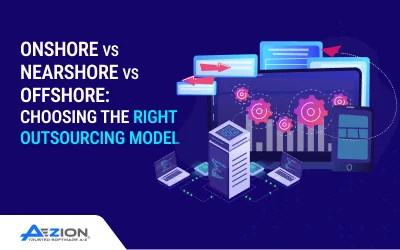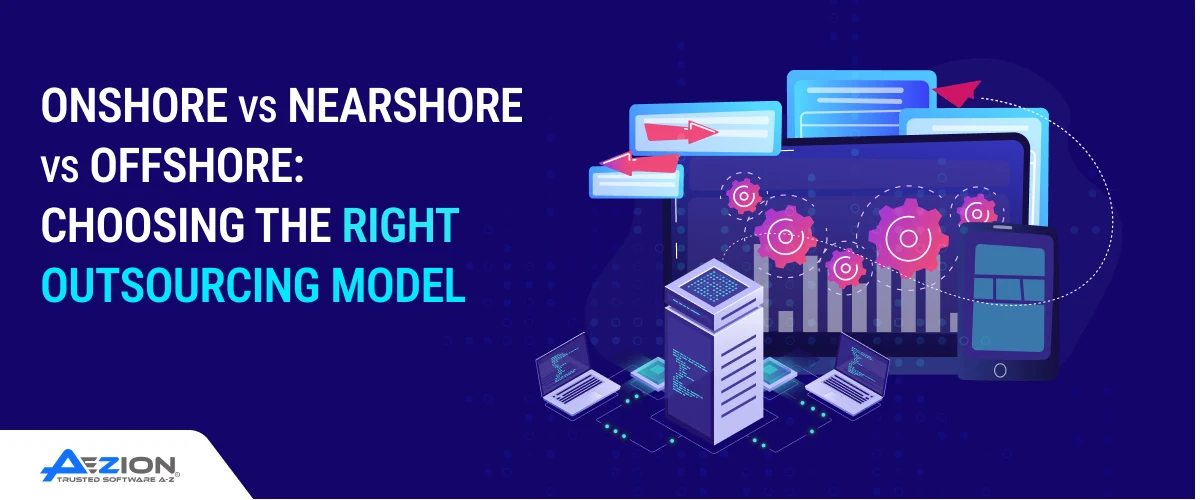Summary
The choice between onshore vs nearshore vs offshore development impacts everything including cost, communication, and project control. This guide breaks down the differences, advantages, and risks between the three to help you evaluate which model best fits your software development goals.
Introduction
The decision between onshore vs nearshore vs offshore development affects cost structure, communication rhythm, and control over the process. Each model supports different goals, depending on available talent, location proximity, collaboration style, and how much oversight the business prefers to maintain.
What do Onshore vs Nearshore vs Offshore Mean?
The terms onshore vs nearshore vs offshore define how geographically close a development partner is to your business. Each model carries different implications for time zone compatibility, communication ease, legal control, and budget making this distinction essential for strategic outsourcing decisions.
What is Onshore Development?
Onshore development refers to outsourcing software projects to teams located within the same country. This model offers high alignment in language, culture, and legal standards, with easier collaboration and faster turnaround due to similar business hours and minimal travel constraints.
What is Nearshore Development?
Nearshore development involves outsourcing to a nearby country with a shared or overlapping time zone. It offers a balance between cost-efficiency and real-time collaboration while reducing cultural gaps, language barriers, and logistical complications found in more distant outsourcing models.
What is Offshore Development?
Offshore development means outsourcing software work to distant countries, often across time zones. This model reduces costs significantly but may involve challenges with communication, cultural alignment, and legal compliance depending on the region selected for development activities.
Onshore vs Nearshore vs Offshore – Comparison Table
A side-by-side comparison of onshore vs nearshore vs offshore models helps highlight practical differences in cost, communication, talent availability, and collaboration. Use this table to evaluate which model fits your development goals based on control, access, and budget constraints.
| Criteria | Onshore | Nearshore | Offshore |
| Location | Based in the same country as the client | Located in neighboring or regional countries | Based in distant countries, often across continents |
| Time Zone Compatibility | Fully aligned with local business hours | Partial to full overlap with working hours | Time difference requires planning but supports 24/7 development cycles |
| Communication | Smooth communication with no language barriers | Generally smooth with minor regional nuances | Effective when structured; English proficiency common in leading hubs |
| Cost | Highest due to domestic labor rates | Moderate cost savings with proximity benefits | Most cost-effective option for long-term or large-scale projects |
| Quality | High quality with strong local oversight | Consistent quality depending on vendor expertise | Competitive quality with experienced providers in global markets |
| Security and Compliance | Strong legal framework and easy regulatory alignment | Good compliance depending on trade agreements | Reliable when working with vetted offshore partners |
| Language and Communication | Same native language, fluent communication | Often fluent, but may involve accents or minor differences | Varies by region; leading destinations offer fluent communication |
| Cultural Affinity | Full cultural match, shared holidays, and norms | Similar work culture with minor differences | Manageable differences; structured onboarding reduces cultural friction |
| Talent Access | Limited to local talent pool | Access to skilled professionals in nearby countries | Access to broader, highly skilled global talent |
| Collaboration Style | Direct, in-person or real-time virtual | Real-time or near real-time virtual coordination | Asynchronous or planned sync-ups; flexibility adds to delivery efficiency |
| Project Control | High control with in-person access | Balanced control with good visibility | Strong control when supported by defined processes and governance |
| Travel Accessibility | Easy travel and on-site coordination | Short travel time, generally convenient | Less frequent travel needed; video conferencing and tools bridge the gap |
| Possibility of Risk | Low risk due to legal alignment and proximity | Moderate risk, manageable through contracts | Manageable with due diligence; experienced partners mitigate major issues |
| Best Suited For | Projects needing close collaboration, high security, and strategic control | Mid-size projects balancing cost and collaboration | Large-scale projects with cost-sensitive budgets and extended timelines |
Onshore vs Nearshore vs Offshore – Key Differences
A deeper look at the onshore vs nearshore vs offshore models reveals how location, communication, and team structure influence outcomes. These differences help decision-makers select the best outsourcing approach based on control, timeline expectations, and access to global development talent.
Location and Time Zone
Onshore teams operate within the same country, offering full overlap in business hours. This setup supports immediate coordination, in-person meetings, and faster issue resolution for projects that require frequent communication and local oversight.
Nearshore development involves nearby countries with partial or complete time zone alignment. It offers real-time or near real-time collaboration, making it easier to coordinate work across teams without major delays or scheduling challenges.
Offshore teams work from distant regions with time differences, but structured planning unlocks 24/7 development. Businesses often gain speed and efficiency when tasks progress overnight or are managed across alternating working hours.
Communication and Collaboration
Onshore teams provide clear communication with no language barriers and shared cultural context. Real-time interaction, face-to-face meetings, and similar business norms make collaboration seamless for projects that demand tight coordination and immediate input.
Nearshore development offers good communication quality, often in the same language or a close variation. Cultural familiarity and overlapping work hours improve responsiveness while keeping collaboration structured, professional, and relatively efficient across regions.
Offshore collaboration requires more structured processes due to time gaps and cultural differences. When managed well, offshore teams maintain strong alignment using defined workflows, dedicated liaisons, and clear reporting for consistent delivery.
Cost and Budget Impact
Onshore development involves the highest cost due to domestic wages, infrastructure, and local compliance. It suits businesses with larger budgets, strict regulatory needs, and the desire for high-touch collaboration within the same legal and economic environment.
Nearshore teams offer moderate savings while maintaining proximity benefits. Rates are usually lower than onshore without sacrificing communication quality. This model works well for mid-sized projects requiring balance between cost control and team coordination.
Offshore development provides the most cost-effective option for large-scale or long-term projects. With careful partner selection, businesses reduce expenses significantly while accessing skilled global talent and maintaining structured oversight across extended delivery cycles.
Talent Pool and Skill Availability
Onshore teams draw from the local talent pool, which may be limited by region or high in demand. This can restrict specialized hiring or delay scaling if niche skill sets are not readily available.
Nearshore development offers broader access to skilled professionals across nearby countries. While slightly more diverse than onshore, availability may still vary depending on specific technologies or the maturity of the partner’s technical ecosystem.
Offshore teams offer wide access to global talent across multiple domains and tech stacks. Many offshore hubs focus on advanced skills, certifications, and scalable teams, making them well-suited for complex and evolving project requirements.
Legal and Compliance Considerations
Onshore development provides the highest level of legal clarity and compliance alignment. Local laws apply, data stays within borders, and intellectual property protection is straightforward, reducing risk for regulated industries and government-related projects.
Nearshore partners often operate under similar or connected legal frameworks, especially in regions with trade agreements. While slightly more complex than onshore, compliance is manageable with clear contracts and local familiarity with data protection norms.
Offshore development requires attention to jurisdiction, data transfer laws, and contract terms. Working with reputable providers ensures strong compliance structures, with many offshore destinations offering established legal systems that support IP rights and global security standards.
Cultural Alignment Language
Onshore teams share the same cultural references, work ethics, holidays, and communication norms. This alignment simplifies project expectations, avoids misunderstandings, and allows seamless collaboration across leadership, development, and product management functions.
Nearshore development often aligns well with client culture due to regional proximity and shared values. Minor language differences may exist, but most teams adapt quickly, maintaining clarity in both written and verbal communication throughout the engagement.
Offshore teams may operate with different cultural norms and accents, but leading offshore destinations have adapted to global standards. Cultural onboarding, clear documentation, and experienced managers help bridge gaps and support productive working relationships.
Pros and Cons of Each Outsourcing Model
Each model in the onshore vs nearshore vs offshore debate offers distinct strengths and trade-offs. Reviewing their pros and cons helps businesses assess which option aligns best with delivery control, budget range, team structure, and communication preferences.
Onshore Development
Pros of Onshore Development
- Real-time collaboration with shared language and culture
- Strong legal protection and regulatory compliance
- Easier access to teams for in-person meetings
Cons of Onshore Development
- Highest cost among all models
- Limited access to specialized or scalable talent
- Hiring delays in competitive domestic markets
Onshore Development Is Best Fit For
- Projects requiring tight control, compliance, and frequent communication
- Ideal for high-budget initiatives focused on transparency and quality
Nearshore Development
Pros of Nearshore Development
- Lower cost compared to onshore with good collaboration
- Partial or full time zone overlap for easier coordination
- Similar cultural and business practices reduce friction
Cons of Nearshore Development
- Slight language or communication nuances may arise
- Legal structures may vary based on the region
- Talent availability may still be limited in emerging markets
Nearshore Development Is Best Fit For
- Mid-sized projects needing balance between cost and communication
- Suitable for teams looking to scale without sacrificing collaboration quality
Offshore Development
Pros of Offshore Development
- Most cost-effective for long-term or large-scale projects
- Broad access to specialized global talent
- 24/7 development cycles with structured handoffs across time zones
Cons of Offshore Development
- Time zone gaps require planned communication
- Cultural differences may need adjustment in the early stages
- Legal and compliance processes vary by country
Offshore Development Is Best Fit For
- Projects with budget constraints and high scalability needs
- Ideal for businesses prioritizing talent access and delivery efficiency
When to Choose Each Outsourcing Model
Knowing when to select onshore vs nearshore vs offshore development depends on your priorities cost, control, collaboration, or scalability. Each model fits a specific scenario, and making the right choice shapes long-term efficiency, delivery success, and project momentum.
Choose Onshore If You Prioritize Control and Collaboration
- Best for projects requiring close oversight and in-person interaction
- Supports seamless real-time communication and cultural alignment
- Ideal for industries with strict compliance or regulatory requirements
- Fits businesses that value transparency, legal clarity, and hands-on management
Choose Nearshore for Balance Between Cost and Communication
- Ideal for businesses seeking moderate cost savings without major time zone gaps
- Offers strong communication and cultural alignment with nearby regions
- Suitable for agile teams needing partial real-time collaboration
- Reduces complexity while maintaining efficiency in project delivery
Choose Offshore for Cost-Driven Large-Scale Projects
- Best for long-term or large-scale builds requiring cost efficiency
- Offers access to a wide talent pool with specialized technical skills
- Suitable when 24/7 development or follow-the-sun models are beneficial
- Works well with structured processes and clear documentation
How to Decide: Key Factors to Evaluate
Selecting between onshore vs nearshore vs offshore development requires careful evaluation of cost, control, scalability, and talent access. This decision should reflect business goals, delivery complexity, and how well internal teams can coordinate with external development partners.
Project Complexity
Complex enterprise systems often require constant alignment across teams. Onshore or nearshore models allow more responsive communication, but well-structured offshore models also handle advanced projects efficiently through documentation, layered delivery, and dedicated communication channels.
Budget
Onshore options involve high labor costs and are often suitable for large enterprises. Nearshore offers cost relief with regional familiarity. Offshore development fits companies seeking substantial savings across long timelines without compromising technical depth.
Time Zone Flexibility
If overlapping hours are non-negotiable, onshore is ideal. Nearshore provides partial or full alignment. Offshore development can be productive when staggered workflows are used, allowing teams to operate in relay for continuous delivery.
Communication Needs
High-touch projects may struggle with asynchronous communication. Onshore supports face-to-face access, while nearshore bridges time gaps with minimal friction. Leading offshore vendors rely on structured processes and fluent teams to maintain project transparency.
Security & Compliance
Regulated industries often choose onshore due to strict local data laws. Nearshore offers decent compliance in treaty-aligned regions. Offshore vendors with mature legal practices and certifications (e.g., ISO/IEC 27001) handle security-sensitive projects confidently.
Scalability
When access to specialized talent or rapid team expansion is a priority, offshore teams present the strongest advantage. Nearshore supports reasonable growth, while onshore hiring may face delays due to local market limitations.
Control Preferences
Onshore teams allow direct involvement and faster decision-making. Nearshore strikes a balance between control and cost. With defined workflows, checkpoints, and governance tools, offshore delivery can maintain control even across continents.
Conclusion
The decision between onshore vs nearshore vs offshore development should reflect your project’s complexity, cost sensitivity, and delivery expectations. An experienced custom software development company assesses these variables and provides strategic guidance to match the right model ensuring high-quality execution, operational efficiency, and alignment with long-term business objectives.
FAQs
What is the difference between onshore and offshore development?
Onshore development uses local teams within the same country, offering close collaboration and legal clarity. Offshore development involves distant teams, focusing on cost savings, global talent, and structured remote project delivery.
Is nearshore development cost-effective?
Yes, nearshore development provides a strong balance between cost and communication. It offers savings over onshore models while maintaining proximity, partial time zone alignment, and smoother collaboration compared to offshore options.
Which outsourcing model is best for startups?
Startups often prefer offshore development for its lower cost and scalable talent pool. However, nearshore may suit early-stage teams that require more collaboration without the high expense of an onshore team.
How do I manage offshore development teams?
Successful offshore management relies on clear documentation, defined workflows, regular check-ins, and dedicated project leads. Using collaboration tools and maintaining transparency helps align expectations and ensures steady progress across time zones.
Can I combine onshore, nearshore, and offshore in one project?
Yes, many businesses use a hybrid model. Core strategy may stay onshore, real-time tasks nearshore, and development offshore. This mix helps optimize costs, improve flexibility, and maintain control across different phases of the project.




